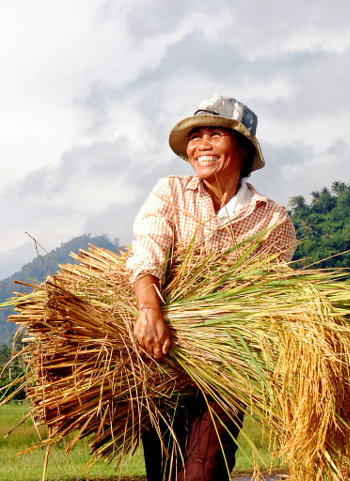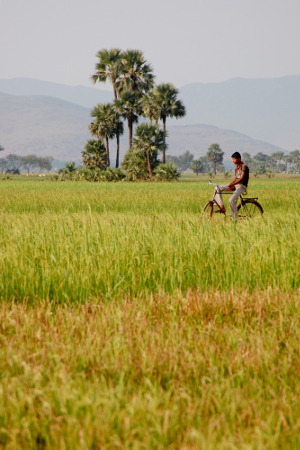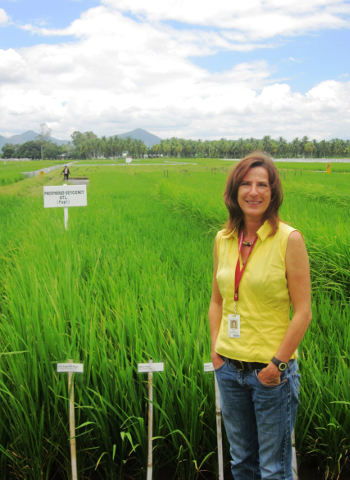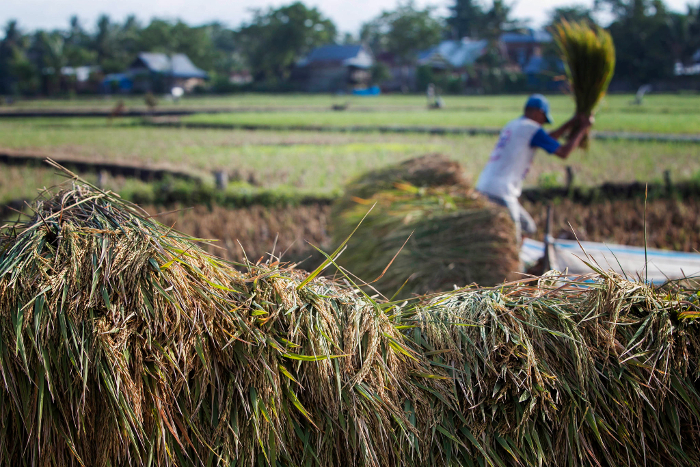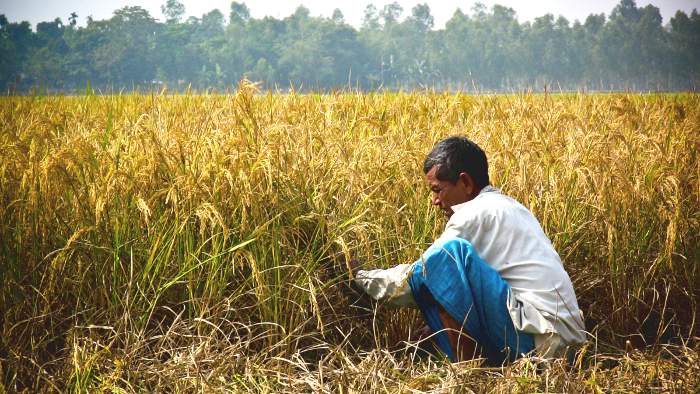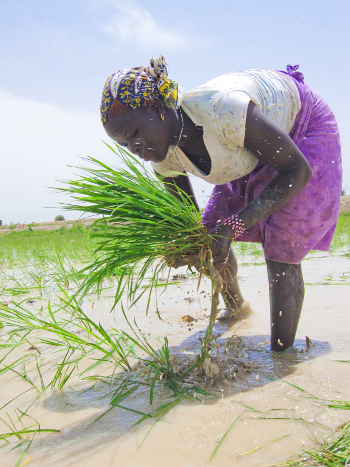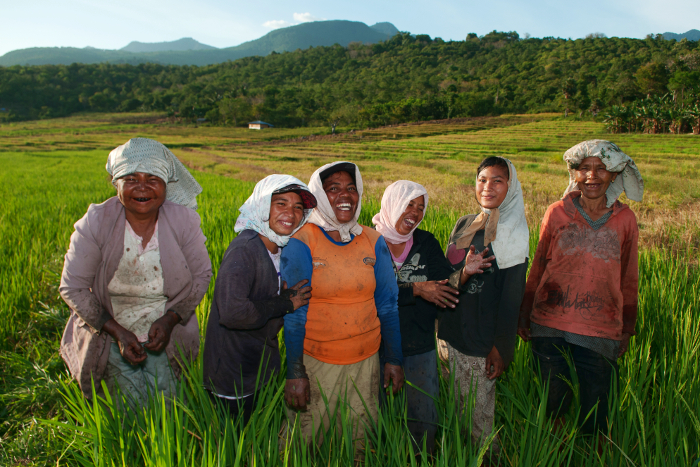Plant geneticist Sigrid Heuer remembers very clearly entering the transgenic greenhouse in Manila to see her postdoctoral student holding up a rice plant with ‘monster’ roots.
“They were enormous,” she recalls. “This is when I knew we had the right gene. It confirmed years of work. That was our eureka moment.
So massive was the effect of that gene that I knew we had the right one.”
This genetic discovery – described in more detail a little later – is one of the shining lights of the 10-year-long CGIAR Generation Challenge Programme (GCP) established in 2004.
GCP-supported researchers aimed high: they wanted to contribute to food security in the developing world by using the latest advances in crop science and plant breeding.
And with the lives of half of the world’s population directly reliant on their own agriculture, there is a lot at stake. Land degradation, salinity, pollution and excessive fertiliser use are just some of the challenges.
Rice is one of the most critical crops worldwide
Amelia Henry, drought physiology group leader at the International Rice Research Institute (IRRI), explains why rice was such a critical crop for GCP research. She says rice is grown in a diverse set of environmental settings, often characterised by severe flooding, poor soils and disease.
In Asia, 40 percent of rice is produced in rainfed systems with little or no water control or protection from floods and droughts – meaning rice plants are usually faced with too much or too little water, and rarely get just enough. In addition, 60 percent (29 million hectares) of the rainfed lowland rice is produced on poor and problem soils, including those that are naturally low in phosphorus.
Phosphorus deficiency and aluminium toxicity are two of the most widespread environmental causes of poor crop productivity in acidic soils, where high acid levels upset the balance of available nutrients. And drought makes these problems even worse.
Phosphorus is essential for growing crops. Its commercial use in fertilisers is due to the need to replace the phosphorus that plants have extracted from the soil as they grow. Soils lacking phosphorus are an especially big problem in Africa, and the continent is a major user of phosphate fertilisers. However, inappropriate use of fertilisers can, ironically, acidify soil further, since excess nitrogen fertiliser decreases soil pH.
Meanwhile, high levels of aluminium in soil cause damage to roots and impair crop growth, reducing their uptake both of nutrients like phosphorus and of water – making plants more vulnerable to drought. Aluminium toxicity is a major limitation on crop production for more than 30 percent of farmland in Southeast Asia and South America and approximately 20 percent in East Asia, sub-Saharan Africa and North America.
The challenge today is to tap into the genetic codes of key crops such as rice and wheat to feed a growing global population. Science plays a crucial role in identifying genes for traits that help plants tolerate more difficult environmental conditions, and producing crop varieties that contain these genes.
Plant biologists are already developing new rice lines that produce higher yields in the face of reduced water, increasingly scant fertiliser as costs rise, and unproductive soils. However, ‘super’ crops are needed that can combine these qualities and withstand climate changes such as increasing temperatures and reduced rainfall in a century when the world’s population is estimated to reach nearly 10 billion people by 2050.
Bringing the best scientific minds to improve rice varieties
Ambitious in concept, the GCP research focussed on bringing together experts to work on these critical problems of rice production for some of the world’s poorest farmers.
The programme was rolled out in two phases that sought to explore the genetic diversity of key crops and use the most important genes for valuable traits, such as Sigrid’s discovery made in a rice variety that is tolerant of phosphorus-poor soils. Each phase involved dedicated teams in partner countries.
GCP Principal Investigator Hei Leung, from IRRI, says GCP is unique, one of kind: “I love it.” He says GCP has enabled rice researchers and breeders to embrace cutting-edge science through partnerships focussed on improving crop yields in areas previously deemed unproductive.
Hei says GCP wanted to target research during its second phase on those crops that most poor people depend upon. “We wanted to have a programme that is what we call ‘pro-poor’, meaning the majority of the world’s people depends on those crops,” he says.
Rice is the ‘chosen one’ of GCP’s cereal crop research and development, with the biggest slice of GCP’s research activities dedicated to this, the most widely consumed staple food.
It is crucial to increase rice supplies by applying research and development such as that carried out by GCP researchers over the past 10 years, Hei says.
For more on the relationship between GCP and IRRI – and an extra sprinkling of salt on your rice (fields) – see our Sunset Story ‘Rice research reaps a rich harvest of products, people and partners’.
Relying on rice’s small genome in the hunt for drought-tolerance genes
Researchers had been trying to map the genomes of key cereal crops for over two decades. Rice’s genome was mapped in 2004, just as GCP started.
Rice has a relatively small genome, one-sixth the size of the maize genome and 40 times smaller than the wheat genome. This makes it a useful ‘model’ crop for researchers to compare with other crops.
“People like to compare with rice because wheat and maize have very big genomes, and they don’t have the resources,” explains Hei.
After the rice genome had been sequenced, the next step was to focus down to a more detailed level: the individual genes that give rice plants traits such as drought tolerance. Identifying useful genes, and markers that act as genetic ‘tags’ to point them out, gives scientists an efficient way to choose which plants to use in breeding.
One of GCP’s Principal Investigators for rice was Marie-Noëlle Ndjiondjop, a senior molecular scientist with the Africa Rice Center.
“Rice is becoming a very important crop in Africa,” she says. “Production has been reduced by a lot of constraints, and drought is one of the most important constraints that we face in Africa.”
Meet Marie-Noëlle below (or on YouTube), in our series of Q&A videos on rice research in Africa.
Marie-Noëlle’s team recognised that drought tolerance was likely to be a complex trait in rice, involving many genes, due to the mix of physiological, genetic and environmental components that affect how well a plant can tolerate drought conditions. To help discover the rice varieties likely to have improved drought tolerance, Marie-Noëlle’s team used an innovative approach known as bi-parental marker-assisted recurrent selection (MARS).
“With such a complex trait, you really need to have all the tools and infrastructure necessary; through GCP we were able to buy the necessary equipment and put in the infrastructure needed to find and test the drought trait in rice lines.
“By using the MARS approach we identified the genetic regions associated with drought and are moving towards developing new rice lines that the African breeder and farmer will be using in the next decade to grow crops that are better able to withstand drought conditions.”
Likewise, Amelia Henry’s IRRI team also developed drought-tolerant lines, particularly for drought-prone areas of South Asia. She says many of the promising deep-rooted or generally drought-tolerant varieties identified in the early decades after IRRI’s foundation in 1960 are still used today as ‘drought donors’.
“Since the strength of our project was the compilation of results from many different sites, this work couldn’t have been done without the GCP partners,” she says. “They taught me a lot about how rice grows in different countries and what problems rice farmers face.”
Hei agrees that GCP partnerships have been crucial, including in the successful breeding of rice with drought tolerance: “They’re getting a 1.5-tonne rice yield advantage under water stress. I mean, that’s unheard of! This is a crop that needs water.”
But the researchers could not rest with just one of rice’s problems solved.
Hei says GCP’s initial focus on drought was a good one but then, “I remember saying, ‘We cannot just go for drought. Rice, like all crops, needs packages of traits’.”
He knows that drought is just one problem facing rice farmers, noting “this broadened our research portfolio to include seeking to breed rice varieties with traits of tolerance to aluminium toxicity, salt and poor soils.”
The scope widens: phosphorus-hungry rice and a huge success
Sigrid Heuer was in The Philippines working for IRRI when she became involved in the ground-breaking phosphorus-uptake project for rice.
She took over the project being headed by Matthias Wissuwa. Much earlier, Matthias had noted that Kasalath – a traditional northern Indian rice variety that grew successfully in low-phosphorus soil – must contain advantageous genes. His postdoctoral supervisor, Noriharu Ae, thought that longer roots were likely to be the secret to some rice varieties being able to tolerate phosphorus-deficient soils.
Matthias, now a senior scientist in the Crop, Livestock and Environment Division at the Japan International Research Center for Agricultural Sciences (JIRCAS), says that for a long time he was not sure if it was just long roots: “It was a real chicken-and-egg scenario – does strong phosphorus uptake spur root growth, or is it the other way around?”
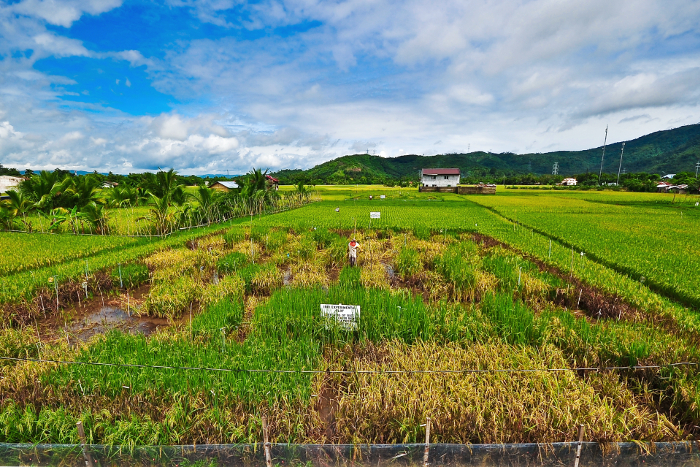
Screening for phosphorus-efficient rice, able to make the best of low levels of available phosphorus, on an IRRI experimental plot in The Philippines. Some types of rice have visibly done much better than others.
Sigrid Heuer used her background in molecular breeding to take up the challenge with GCP to find the genes responsible for the Kasalath variety’s long roots.
“I spent years looking for the gene,” Sigrid says. “It was like trying to find a needle in a haystack; the genomic region where the gene is located is very complex.
“We had little biogenomics support at the time and I had three jobs and two kids; I was spending all my nights trying to find this gene.”
But one day, Sigrid’s postdoctoral student Rico Gamuyao excitedly called her downstairs to the transgenic greenhouses. “Rico had used transgenic plants to see whether this gene had any effect. He was digging out plants from experimental pods.”
Sigrid says that moment in the Manila labs was the turning point for the project’s researchers.
Matthias’ team had previously identified a genomic region, or locus, named Pup1 (‘phosphorus uptake 1’) that was linked to phosphorus uptake in lines of traditional rice growing in poor soils. However, its functional mechanism remained elusive until the breakthrough GCP-funded project sequenced the locus, showing the presence of a Pup1-specific protein kinase gene, which was named PSTOL1 (‘phosphorus starvation tolerance 1’). The discovery was reported in the prestigious scientific journal Nature on 23 August 2012 and picked up by media around the world.
The gene instructs the plant to grow larger and longer roots, increasing its surface area – which Sigrid compares to having a bigger sponge to absorb more water and nutrients in the soil.
“Plants growing longer roots have more uptake of phosphorus – and PSTOL1 is responsible for this.
“GCP was always there, supporting us and giving us confidence, even when we weren’t sure we were going to succeed,” she recalls. “They really wanted us to succeed, so, financially and from a motivational point of view, this gave us more enthusiasm.”
She adds, jokingly, “With so many people having expectations about the project, it was better not to disappoint.”
For some insight straight from the source, listen to Matthias in our podcosts below. In these two bitesized chunks of wisdom he discusses the importance of phosphorus deficiency and of incorporating PSTOL1 into national breeding programmes; his work in Africa and the possibility of uncovering an African ‘Pup2’; what the PSTOL1 discovery has meant for him; and the essential contribution of international partnerships and GCP’s support.
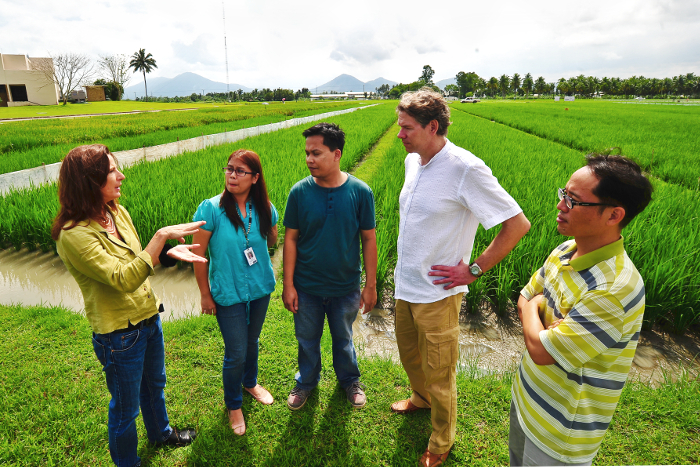
Members of the IRRI PSTOL1, phosphorus uptake research team chat in the field in 2012. From left to right they are are: Sigrid Heuer, Cheryl Dalid, Rico Gamuyao, Matthias Wissuwa and Joong Hyoun Chin.
Phosphorus-uptake gene not all it seemed – an imposter?
But PSTOL1 was definitely not what it seemed. “It was identified under phosphorus-deficient conditions and the original screen was set up for that,” says Sigrid.
Researchers eventually discovered that Pup1 and the PSTOL1 gene within it were not really all about phosphorus at all: “It turns out it is actually a root-growth gene, which just happens to enhance uptake of phosphorus and other nutrients such as nitrogen and potassium.
“The result is big root growth and maintenance of that growth under stress. If you have improved root growth, there is more access to soil resources, as a plant can explore more soil area with more root fingers.”
Her team showed that overexpression of PSTOL1 gene significantly improves grain yield in varieties growing in phosphorus-deficient soil – by up to 60 percent compared to rice varieties that did not have the gene.
In field tests in Indonesia and The Philippines, rice with the PSTOL1 gene produced about 20 percent more grain than rice without the gene. This is important in countries where rice is grown in poor soils.
Sigrid, now based in Adelaide at the Australian Centre for Plant Functional Genomics, says the introduction of the new gene into locally adapted rice varieties in different locations across Asia and Africa is expected to boost productivity under low-phosphorus conditions.
“The ultimate measure for these kinds of projects is whether a gene works in different environments. I think we have a lot of evidence that says it does,” she says.
The discovery of PSTOL1 promises to improve the food security of rice farmers on phosphorus-deficient land though assisting them to grow more rice and earn more.
Titbits of further research successes: aluminium tolerance and MAGIC genes
Drought, low-phosphorus soils, aluminium toxicity, diseases, acid soils, climate change… the list seems never-ending for challenges to growing rice. Apart from the successes with drought and phosphorus that GCP scientists achieved, there was to be much more in the works from other GCP researchers.
During GCP Phase I, a team led by Leon Kochian of Cornell University, USA, with colleagues at the Brazilian Corporation of Agricultural Research (EMBRAPA), JIRCAS and Moi University, Kenya, successfully identified and cloned a major sorghum aluminium-tolerance gene.
In Phase II, they worked towards breeding aluminium-tolerant sorghum lines for sub-Saharan Africa, as well as applying what they learnt to discover similar genes in rice and maize.
Hei Leung says GCP leaves a lasting legacy in the development of multiparent advanced generation intercross (MAGIC) populations. These help breeders to identify valuable genes, and from among the populations they can also select lines to use in breeding that have favourable traits, such as being tolerant to environmental stresses, having an ability to grow well in poor soils or being able to produce better quality grain.
“MAGIC populations will leave behind a very good resource towards improving different crop species,” says Hei. “I’m sure that they will expand on their own.”
GCP funded the development of four different MAGIC populations for rice, including both indica and japonica types. And the idea of developing MAGIC populations has spread to other crops, including chickpeas, cowpeas and sorghum.
For more on MAGIC see our Sunset Story ‘Rice research reaps a rich harvest of products, people and partners’.
Meeting the challenges and delivering outcomes to farmers
But with success come the frustrations of getting there, according to Nourollah Ahmadi, GCP Product Delivery Coordinator for rice across Africa. “This is because things are not always going as well as you want.”
Nourollah, from Centre de coopération internationale en recherche agronomique pour le développement (Agropolis–CIRAD; Agricultural Research for Development), says sometimes he felt overwhelmed coordinating GCP’s rice projects because “the challenges were perhaps too big.”
Project Delivery Coordinators monitor projects first-hand, conducting on-site visits, advising project leaders and partners and helping them implement delivery plans.
“One of the problems was the overall level of basic education of people who were involved in the project,” Nourollah says.
His work with GCP has opened up new prospects for some of the poorest farmers in the world: “For five years, I have been coordinating one of the rice initiatives implemented by the Africa Rice Center and involving three African countries.” These are Burkina Faso, Mali and Nigeria.
He says GCP has brought much-needed expertise and technical skills to countries which can now use genetic insights to produce improved crops tolerant of drought conditions and poor soils and resistant to diseases. Using new molecular-breeding techniques has provided a more effective way to move forward, still firmly focussed on helping the world’s poorest farmers achieve food security.
“We don’t change direction, we change tools – sometimes you have a bicycle, sometimes you have a car,” Nourollah says.
Hei agrees there have been challenges: “It’s been a bumpy road to get to this point. But the whole concept of getting all the national partners doing genetic resource characterisation is a very good one.
Right now they are enabled; they are not scared about the technology. They can apply it.”
Sigrid says applied research is judged on two scales: “One is the publications and science you’re doing. The other is whether the work has any impact in the field, whether it works in the field. Bringing these two together is sometimes a challenge.”
GCP has managed to meet both challenges. New crop varieties have been released to farmers, and more than 450 scientifically reviewed papers have been published since 2004.
Building on the rice success story and leaving a lasting legacy
The work that GCP-supported researchers have done for rice is also being used in other crops. For example, researchers used comparative genomics to determine if genes the same as or similar to those found in rice are present and operating in the same manner in sorghum and maize.
The GCP team found sorghum and maize varieties that contained genes, similar to rice’s PSTOL1, that also confer tolerance of phosphorus-deficient soil with an enhanced root system. They were then able to develop markers to help breeders in Brazil and Africa identify phosphorus-efficient lines.
The knowledge that GCP-supported rice researchers have generated is shared through communities of practice, through websites, publications, research meetings and the Integrated Breeding Platform.
As Amelia Henry notes, GCP’s achievements will be defined by “the spirit of dedication to openness with research data, results and germplasm and giving credit and support to partners in developing countries.” The work in rice in many ways exemplifies GCP’s collaborative approach, commitment to capacity building and deeply held belief that together we can go so much further in helping farmers.
Unlocking genetic diversity in crops for the resource-poor was at the heart of GCP’s mission, which in 2003 promised ‘a new, unique public platform for accessing and developing new genetic resources using new molecular technologies and traditional means’.
Certainly for poor rice farmers in Asia and Africa, the work that GCP has supported in applying the latest molecular-breeding techniques will lead to rice varieties that will help them produce better crops on poor soils in a changing climate.
More links
- Here on the Sunset Blog, discover the full story of sister genes, acid soils and comparative genomics
- And get an extra Sunset helping of rice in our tale of GCP’s relationship with IRRI, with more on MAGIC populations and breeding for salinity tolerance
- Rice Blogposts | Research Initiative | InfoCentre
- Comparative Genomics Blogposts | Research Initiative | InfoCentre
- The PSTOL1 discovery press release | Nature article | Nature commentary by Leon Kochian








